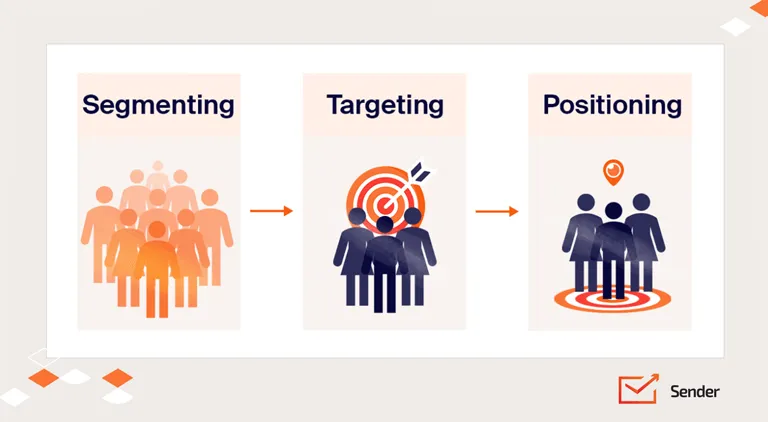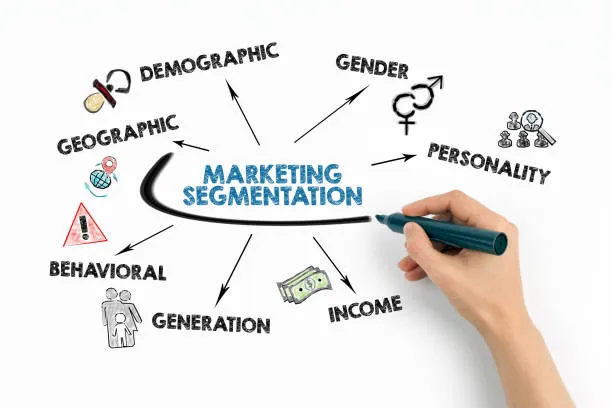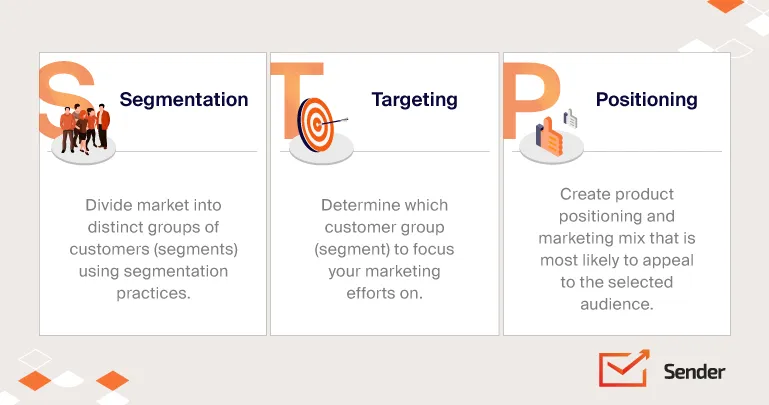What is STP strategy ? STP is an important marketing strategy that helps businesses gain an effective competitive advantage by focusing on serving a group of customers in a specific target market. Let’s find out what STP in marketing is as well as how to apply STP marketing effectively in the article below.

What is STP?
STP is a famous strategic model in Marketing.
STP stands for three words: Segmentation, Targeting and Positioning. Simply put, STP is a strategy that helps businesses identify market segments, select specific target markets as well as successfully position their brand.
When applying the STP strategy in marketing, businesses will focus their resources on exploiting one or several customer groups where they have a competitive advantage (target market), building their own, clear image. on that market.
Instead of targeting a large number of different customers without selection, wasting time and resources, with the STP strategy, businesses will only focus on a few customers with different characteristics. certain similar characteristics, thereby designing a marketing strategy suitable to your target market and achieving high business efficiency.
What are the elements in STP?
After learning the definition of STP , what are the main elements in STP?
The STP strategy includes three main elements as follows.
S – Segmentation (Market Segmentation)

The first element in STP is Segmentation – Market Segmentation.
What is market segmentation in STP?
Market segmentation, in English, Market Segmentation, is the activity of dividing customers in a target market into different subgroups. These customer groups will have similar characteristics, needs and responses.
Dividing different customer groups can be based on specific customer characteristics such as age, income, personality traits or behavior. These segments can then be used to optimize products and advertising for different customer segments.
Businesses can better understand each target customer by capturing their main characteristics, needs as well as behavior and psychology from which to build marketing strategies as well as marketing strategies. Sales appropriate to each market segment.
Necessary criteria for each market segment
When determining market segments, what criteria should businesses pay attention to? Each market segment needs to have the following criteria:
- Feasibility: With the feasibility factor, businesses need to possess enough resources (human resources, finance, equipment and technology) to serve the identified target customers.
- Measurable: Businesses need to be able to measure factors such as customer purchasing power, segment size and product revenue as well as market segment profitability.
- Profitable: The market segments that the business identifies need to be large enough, have a large number of customers with certain needs and generate enough profit for the business to continue operating.
- Differentiation: The market segment for young people will be different from that for middle-aged people. This means that each market segment of the business must be different and serve different audiences.
The purpose of identifying market segments in STP
Basically, determining market segments has the following three main purposes.
- First, identifying market segments helps bring competitive advantages to businesses.
With the development of the Internet, businesses have more ways to reach customers , thereby increasing the level of competition between businesses. Therefore, possessing a competitive advantage to attract and convince customers is important and necessary.
To have a competitive advantage, businesses need to accurately identify their market segments.
When determining market segments, businesses can convey messages and content of marketing campaigns in a way that best suits customer needs, thereby attracting customers more effectively and convincing them. Choose to pay for the products/services your business provides instead of your competitors’ products/services.
- Second, identifying market segments helps businesses build effective marketing strategies
The next purpose of identifying market segments is to build effective marketing strategies.
Identifying different types of market segments will help marketing strategies work more effectively. When a business knows who it wants to target, it will be able to easily deploy the best solutions and methods to reach them.
- Third, identifying market segments helps businesses build relationships with customers
Understanding customers by identifying market segments will help businesses produce and develop better quality products that suit customer needs as well as provide effective solutions to help customers. products solve their problems.
4 ways to classify the most popular markets
Market segmentation by geography
Geographic market segmentation is when businesses create different target customer groups based on geographical boundaries.
Because potential customers have different needs and preferences based on where they live, understanding the climate and geography of customer groups can help businesses determine which locations to reach out to. Which geographical areas are included in advertising campaigns as well as where to expand your business in the future?
Examples of geographic target market segmentation include:
- ZIP code
- Province, city
- Nation
- Radius around a certain location
- Climate
- Urban or rural
Market segmentation by demographics
Demographics is the analysis of a business’s customer persona in its target market based on demographic characteristics. These characteristics provide basic information about the target customer and are often considered one of the broad types of target market segmentation.
Examples of customer information to segment target markets by demographics are as follows:
- Job
- Marital status
- Education
- Nation
- Religion
- Monthly or yearly income
Market segmentation according to customer psychology
Psychographic segmentation factors are somewhat more difficult to determine than demographics because psychographic factors are subjective. Market segmentation based on customer psychology does not focus much on data and requires businesses to research to explore and learn.
Examples of customer psychological characteristics include:
- Personality traits
- Value
- Attitude
- Interest
- Style of life
- Psychological influencing factors
Market segmentation according to customer behavior
Classifying target markets by behavior requires businesses to understand customer behaviors. These behaviors can be related to how customers and businesses interact with each other.
Examples of customer behavioral characteristics include:
- Purchasing habits
- Spending habits
- Customer mood
- Interact with businesses
>> Read more: What is market segmentation & 4 common types of market segmentation
T – Targeting in STP

The second element of STP is the Targeting element – Target market.
What is the target market (Targeting) in STP?
Target market is the segmentation of customers into certain groups in accordance with the strategy and goals of each business. In other words, the target market includes potential customers who are really interested in the business’s products and services.
This specific customer group is the customer group that businesses want to reach through their marketing activities and campaigns. This is a group of customers who are more likely to be interested in the business’s products and services than other customer groups. As for the target customer group, they share common characteristics such as: demographics, education level, income, psychology and behavior,…
Why do businesses need to choose target markets?
The main and most important reason for choosing a target market is to help businesses determine their competitive advantage.
Target market classification gives businesses a competitive advantage by identifying a new market that the business can focus on reaching.
By classifying target markets, businesses can identify untapped and growing markets with low competition. By identifying a target market with high growth potential and low competition, a business can expand its potential customer base and ultimately boost product advertising and sales.
With an understanding of the target market, businesses can clearly understand what customers want from their products and services. That way, creating a suitable strategy to meet customer needs and expectations will help businesses gain a competitive advantage over competitors.
Besides, choosing the target market also helps increase effective conversion rates.
When a business delivers the right messages to customers in its target market, it is more likely to attract the right audience. That audience will be more interested in your product and willing to pay for it than other customers who are not in the target market.
If a business is able to connect with the right customer segments, they are more likely to be high-quality and qualified leads that can be converted into customers, helping the business increase sales.
Methods of selecting target markets
Focus on a specific market segment
For this method, businesses will only choose to target a specific market segment.
The advantage of this method is that it helps businesses focus all their resources on the market segment where the business has strengths. However, when using this method, customers will be fewer and it will be difficult to develop scale and build a brand.
Selective specialization
For this method, businesses will select a number of market segments to operate, each market segment has objective appeal and is suitable for the business’s goals and resources.
The advantage of this method is that it helps businesses diversify risks. Even if one market segment becomes unattractive, the business can still continue to gain profits from other market segments.
However, businesses need to possess great potential to satisfy the needs of different market segments, otherwise it will easily lead to a situation where the business does not serve all market segments well and faces failure. lose.
Specialization according to market characteristics
With this approach, businesses focus on serving the needs of a single target market and develop many different products for this target market.
The advantage that the specialization method based on market characteristics brings is that it helps businesses have a competitive advantage over their competitors because they specialize in serving a specific customer group and will become more competitive. More trustworthy in customer perception.
However, the risk is that if that entire market segment no longer uses the business’s products, the loss the business will suffer will be huge.
Covering the entire market
With this method, businesses aim to serve the entire market with an undifferentiated marketing strategy. Selecting the target market according to this method will focus on finding common ground in customer needs rather than producing differentiated products.
The advantage of the total market coverage approach is to serve the entire market by mass producing and reaching all customers with a single message and marketing strategy, regardless of that audience’s relationship with each other. How is it related to the business and what benefits can the business bring?
The disadvantage is that only large businesses can implement this method because they must satisfy requirements such as: the product must be suitable for almost the entire market, a strong distribution network with strong strategies. widespread communication and promotion.
>> Read more : 6 steps to effectively identify target markets
P – Positioning (Brand Positioning) in STP

The final element in STP is Positioning – Brand Positioning.
What is brand positioning in STP?
According to Philip Kotler – a famous expert in the Marketing industry, defines brand positioning as follows: ” Brand positioning is a set of activities aimed at creating a unique position for products and brands. (compared to competitors) in the mind of the customer.
When it comes to the definition of brand positioning, according to Marc Filser, “brand positioning is an effort to give a product a unique image that easily enters the customer’s awareness. Or more specifically, what businesses want customers to think of every time their brand is mentioned.”
Why do businesses need brand positioning?
Businesses need to position their brand for the following 3 reasons.
- First, brand positioning helps customers remember the business
When conveying messages that help position a business’s brand effectively, customers will remember the business more easily, contributing to creating an impression on customers and the business also has the ability to penetrate the public’s awareness. customer consciousness.
- Second, brand positioning helps businesses possess a competitive advantage
Determining your position in the brand positioning process is a method used to create a different image for a business’s products compared to competitors’ products.
- Third, brand positioning helps businesses build appropriate advertising messages.
With good brand positioning, a business’s advertising message can attract customers’ attention by conveying clear ideas about differentiation, uniqueness as well as the benefits that customers expect. .
Brand positioning strategies
Businesses can apply the following two brand positioning strategies.
- Direct competitive positioning strategy
For this strategy, businesses will convince customers by emphasizing the benefits of the products they provide compared to competitors’ products.
When using a direct competitive positioning strategy, competitor products are used as points of comparison with the business’s products.
- Strategy to occupy a new position
The positioning strategy of occupying a new position is a strategy in which a business finds a vacant space in a market with no competitors.
Businesses applying this strategy need to find and pursue a target market that no other business has followed or the competition in that market is negligible.
For the strategy of occupying a new position, the market will not be a place of fierce competition, but of intellectual competition, creating things that no one has done or thought of. Businesses applying this positioning strategy will be pioneers and leaders in a certain specific market.
Main requirements when positioning a brand
When positioning a brand, businesses need to meet the following needs:
- Clarity : Your own image must be clear to be noticed and remembered by customers.
- Consistency : It is necessary to build a consistently consistent image and position
over a period of time long enough to be portrayed in the customer’s mind.
- Honesty, trust (credibility): The image of the business needs to make customers feel trustworthy and convince customers to choose the business’s products.
What is the role of STP strategy in Marketing?

After learning the definition of STP as well as the elements in STP, should businesses apply an STP strategy? What is the role of STP strategy in Marketing?
STP strategy brings competitive advantage to businesses
When applying the STP strategy, instead of focusing on many different customers without selection, businesses will target a specific target customer and build appropriate marketing strategies to attract that customer base.
Communication messages that are suitable for specific customers will help businesses create a better image in the minds of customers, thereby convincing them to use the products that the business provides instead of using your products. competitors.
STP strategy helps businesses increase sales
In a competitive business environment, businesses need to effectively persuade customers and encourage them to choose their products.
Possessing a competitive advantage when using the STP strategy will help businesses successfully increase sales by identifying competitive advantages and effectively attracting customers.
STP strategy helps businesses build appropriate marketing strategies
Each customer and market segment will have different needs. Therefore, when accurately determining the target market and segment that you are targeting, businesses can easily build and deploy appropriate marketing strategies to attract customers.
Basically, there are 4 popular and effective marketing strategies that businesses can apply including:
- Differentiation Marketing Strategy (Differentiation Strategy)
- Positioning Marketing Strategy
- Marketing strategy according to product cycle
- Marketing strategies for market leaders, challengers and followers
Read more details about the above 4 Marketing strategies in the article: [Summary] Effective marketing strategies
4 steps to build an effective STP Marketing strategy
How to apply effective STP strategy in Marketing?
In general, the process of applying the STP strategy includes the following 4 steps.
Step 1: Market research
The first step in applying the STP strategy is market research.
Market research or Market Research is a process of collecting, processing, and analyzing information related to customers, competitors, and target markets with the purpose of helping businesses deploy marketing strategies. more suitable to improve customer experience and increase conversion rates.
Market research is very important, because this work helps businesses minimize risks and orient their business effectively. If businesses subjectively conduct unclear market research or do not learn about the market before doing business, serious consequences such as waste of resources, costs and even complete failure will be at risk of occurring. out high.
The 7 key steps in market research include:
- Step 1: Identify target market
- Step 2: Build customer portraits
- Step 3: Identify the specific customer group that needs to be surveyed
- Step 4: Analyze competitors
- Step 5: Choose a research method
- Step 6: Design questions for the survey
- Step 7: Summarize the collected data
You can learn more details about the 7 steps of market research in the article : What is market research & 6 steps of effective market research
Step 2: Identify market segments

Once you have researched the market in which your business is implementing business activities, the next step is to determine the market segment that your business is targeting.
Businesses can apply a 4-step process to identify market segments as follows.
- Step 1: Understand your business’s current customers
- Step 2: Identify target customers
- Step 3: Identify the appropriate segment
- Step 4: Analyze and evaluate the effectiveness of the selected market segment
Read details about the steps to determine market segmentation in the article : What is market segmentation? How to effectively identify market segments
Step 3: Select target market
After determining the market segment, in this step, businesses will choose the target market that is suitable for their products as well as their business field.
There are 6 steps for businesses to choose the appropriate target market:
- Step 1: Find out the niche market
- Step 2: Learn about your current customers
- Step 3: Analyze data
- Step 4: Learn about competitors
- Step 5: Understand the product features and benefits that the business offers
- Step 6: Evaluate the effectiveness of the target market
Read more details about the 7 steps to selecting a target market in the article : What is a target market & 7 steps to identify and implement effectively for every Business
Step 4: Brand positioning
The final step in the process of applying STP is brand positioning.
When positioning a brand, businesses need to draw a positioning map, positioning options as well as build a Marketing Mix program based on the positioning plan.
First, to position the brand, businesses need to draw a positioning map.
The business’s brand positioning map includes 2 coordinate axes. Each axis represents a different value/attribute of the brand.
The two most common factors when creating a brand positioning map are:
- Price segment (High or low price)
- Quality or more specific attributes that represent product quality (product design, product performance, etc.)
Then, based on research on communication methods and various marketing activities, businesses can determine the position of their brand as well as their competitors’ brands on this coordinate system. From there, determine your positioning relative to your competitors.
Next, businesses need to determine their positioning plan.
Some positioning options that businesses can apply include:
- Positioning through product characteristics: Businesses will rely on product characteristics such as technical characteristics, usage characteristics or product design and style to position the brand.
- Positioning through services: Businesses will position their brand based on services such as home delivery, installation, consulting, repair…
- Positioning through people: Human factors such as employee friendliness or employee knowledge about the product is also a successful brand positioning option.
- Positioning through images: Positioning the brand through logos, symbols, and typical colors of the business.
Finally, businesses need to build a Marketing Mix program
After determining the image and position of the brand, businesses need to build marketing mix programs. The marketing mix program system is designed based on a predetermined positioning concept, in accordance with the selected positioning plan and must have coordination to demonstrate the consistency of the positioning image.
Summary of STP
STP strategy is an important strategy in Marketing, helping businesses have a competitive advantage by focusing on implementing Marketing campaigns aimed at a specific target audience.
In this article, we have introduced to you detailed information about the STP strategy such as:
- What is STP?
- What are the key elements of STP?
- What is the role of STP in Marketing
- What are the 4 steps to apply the STP strategy?
Hopefully through this article, you will be able to understand more about what the STP strategy is and how to apply the STP strategy. Thank you.
Check out some other good articles:
- What is Affiliate Marketing? How to do Affiliate Marketing effectively
- What is trade marketing? The 4 most important trade marketing jobs




